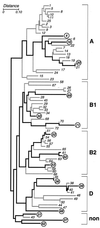Improved repetitive-element PCR fingerprinting for resolving pathogenic and nonpathogenic phylogenetic groups within Escherichia coli
- PMID: 10702503
- PMCID: PMC95859
- DOI: 10.1128/CDLI.7.2.265-273.2000
Improved repetitive-element PCR fingerprinting for resolving pathogenic and nonpathogenic phylogenetic groups within Escherichia coli
Abstract
Repetitive-element PCR (rep-PCR) fingerprinting is a promising molecular typing tool for Escherichia coli, including for discriminating between pathogenic and nonpathogenic clones, but is plagued by irreproducibility. Using the ERIC2 and BOXA1R primers and 15 E. coli strains from the ECOR reference collection (three from each phylogenetic group, as defined by multilocus enzyme electrophoresis [MLEE], including virulence-associated group B2), we rigorously assessed the effect of extremely elevated annealing temperatures on rep-PCR's reproducibility, discriminating power, and ability to reveal MLEE-defined phylogenetic relationships. Modified cycling conditions significantly improved assay reproducibility and discriminating power, allowing fingerprints from different cyclers to be analyzed together with minimal loss of resolution. The correspondence of rep-PCR with MLEE with respect to tree structure and regression analysis of distances was substantially better with modified than with standard cycling conditions. Nonetheless, rep-PCR was only a fair surrogate for MLEE, and when fingerprints from different days were compared, it failed to distinguish between different clones within all-important phylogenetic group B2. These findings indicate that although the performance and phylogenetic fidelity of rep-PCR fingerprinting can be improved substantially with modified assay conditions, even when so improved rep-PCR cannot fully substitute for MLEE as a phylogenetic typing method for pathogenic E. coli.
Figures




Similar articles
-
Improved repetitive-element PCR fingerprinting of Salmonella enterica with the use of extremely elevated annealing temperatures.Clin Diagn Lab Immunol. 2000 Mar;7(2):258-64. doi: 10.1128/CDLI.7.2.258-264.2000. Clin Diagn Lab Immunol. 2000. PMID: 10702502 Free PMC article.
-
Semi-automated rep-PCR for rapid differentiation of major clonal groups of Escherichia coli meningitis strains.Int J Med Microbiol. 2009 Aug;299(6):402-9. doi: 10.1016/j.ijmm.2009.04.001. Epub 2009 May 17. Int J Med Microbiol. 2009. PMID: 19451030
-
Molecular analysis of a hospital cafeteria-associated salmonellosis outbreak using modified repetitive element PCR fingerprinting.J Clin Microbiol. 2001 Oct;39(10):3452-60. doi: 10.1128/JCM.39.10.3452-3460.2001. J Clin Microbiol. 2001. PMID: 11574555 Free PMC article.
-
Optimization of analytical parameters for inferring relationships among Escherichia coli isolates from repetitive-element PCR by maximizing correspondence with multilocus sequence typing data.Appl Environ Microbiol. 2006 Sep;72(9):6049-52. doi: 10.1128/AEM.00355-06. Appl Environ Microbiol. 2006. PMID: 16957228 Free PMC article.
-
Rep-PCR--a variant to RAPD or an independent technique of bacteria genotyping? A comparison of the typing properties of rep-PCR with other recognised methods of genotyping of microorganisms.Acta Microbiol Pol. 2001;50(3-4):189-204. Acta Microbiol Pol. 2001. PMID: 11930988 Review.
Cited by
-
Prevalence of plasmid-mediated AmpC beta-lactamases in a Chinese university hospital from 2003 to 2005: first report of CMY-2-Type AmpC beta-lactamase resistance in China.J Clin Microbiol. 2008 Apr;46(4):1317-21. doi: 10.1128/JCM.00073-07. Epub 2008 Feb 27. J Clin Microbiol. 2008. PMID: 18305137 Free PMC article.
-
Genomic fingerprints of Escherichia coli strains isolated from surface water in Alborz province, Iran.BMC Res Notes. 2017 Jul 20;10(1):295. doi: 10.1186/s13104-017-2575-z. BMC Res Notes. 2017. PMID: 28728566 Free PMC article.
-
Chicken as reservoir for extraintestinal pathogenic Escherichia coli in humans, Canada.Emerg Infect Dis. 2012 Mar;18(3):415-21. doi: 10.3201/eid1803.111099. Emerg Infect Dis. 2012. PMID: 22377351 Free PMC article.
-
A Novel High-Resolving Method for Genomic PCR-Fingerprinting of Enterobacteria.Acta Naturae. 2010 Apr;2(1):82-8. Acta Naturae. 2010. PMID: 22649631 Free PMC article.
-
Evaluation of genotyping large numbers of Escherichia coli isolates by enterobacterial repetitive intergenic consensus-PCR.J Clin Microbiol. 2003 Nov;41(11):5224-6. doi: 10.1128/JCM.41.11.5224-5226.2003. J Clin Microbiol. 2003. PMID: 14605168 Free PMC article.
References
-
- Arbeit R D, Maslow J N, Mulligan M E. Polymerase chain reaction-mediated genotyping in microbial epidemiology. Clin Infect Dis. 1994;18:1018–1019. - PubMed
-
- Berg D E, Akopyants N S, Kersulyte D. Fingerprinting microbial genomes using the RAPD or AP-PCR method. Methods Mol Cell Biol. 1994;5:13–24.
Publication types
MeSH terms
Substances
Grants and funding
LinkOut - more resources
Full Text Sources
Other Literature Sources

